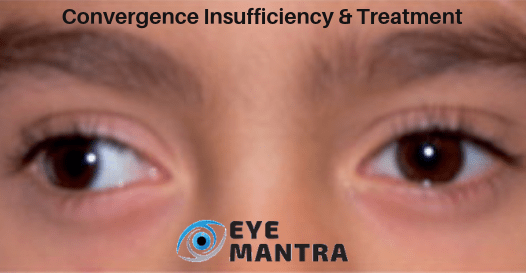Contents
About Convergence Insufficiency
Convergence insufficiency (CI) is a condition in which your eyes are unable to focus at nearby objects, together. You may face such a condition whether you are reading a book, tying your shoe or sending a text message. To put it simply, CI causes one eye to turn at a different angle than the other eye. It limits a person’s ability to work with visual information at close distances and creates double or blurred vision. However, a few simple convergence exercises, done regularly, are usually effective to treat this insufficiency.
It may even limit activities. Because the insufficiency, in severe conditions, prevents people from seeing three-dimensional
CI is quite normally found in school-going children and adolescents. At this age, when the child has to spend a long time reading texts on paper, it leads to weakness of eye muscles and discomfort in the eyes. While the parents or teachers might suspect the child has learning difficulties and not an eye disorder.
However, nowadays, it is not limited to children only. Even as adults, when we spend a prolonged time in front of our computers and androids, which have become an unavoidable part of our lives. It causes visual strain. And convergence weakness. To strengthen your eyes muscles, the best cure is by regular eye convergence exercises. Except in critical conditions, when you must consult the best Eye Hospital Delhi.
Symptoms of CI

Both our eyes are parallel to each other when we look straight ahead at a distant object. As the object comes closer, the two eyes move towards each other – converge. Normally, the eyes can converge to look at an object as close as 5 to 8 cm to the eyes.
But in CI, this point goes back to more than 12 cms away.
You are most likely to notice symptoms of CI at the time of doling some close visual work. Such as reading. Symptoms are even more visible if you have been reading for long durations. Fatigue and extreme tiredness can also cause symptoms.
But remember, not everyone with this insufficiency has signs and symptoms.
Possible symptoms include:
- Eyestrain,
- Tired, sore or uncomfortable eyes,
- Headaches,
- Difficulty in reading — words blur together or seem to float on the page,
- You lose the spot where you are reading or you read slowly,
- Needing to re-read things a few times,
- Sleepiness when reading,
- Double vision (diplopia),
- Trouble concentrating,
- Squinting, rubbing or closing one eye,
- Motion sickness or vertigo.
Others may notice that one of your eyes, sometimes, turns at different angles, as you read. This might also happen at the same time you are facing blurred vision. They may, also, notice you squinting or closing one of your eyes while you read. (This might make it easier for you to have a focused, single image.)
Causes of Convergence Insufficiency
CI occurs from misalignment of the eyes when focusing on nearby things.
The exact cause isn’t known, but this misalignment involves the muscles that move the eye. And there are problems with coordinating the eye muscles and eye movements. Instead of moving together to focus on nearby objects, one or both eyes tend to drift away from that object.
Eye movements are controlled by the brain. Some types of neurologic impairment may cause this insufficiency. The condition is quite common in children with some forms of neurologic impairment. In some cases, a brain injury or neurodegenerative disease, such as Parkinson’s disease, can also be a cause.
But the eye muscles themselves are normal in these patients. In fact, the vast majority of children with CI are completely normal otherwise.
Therefore, the experts are not yet sure what causes CI.
There may be problems in the complex series of operations that the brain and eyes perform.
Genes may also be the culprit at times. You or your children may be at higher risk for CI if some family members have had it.
In some instances, a health condition can lead to CI. These include:
- Head injury and concussion
- Graves disease
- Myasthenia gravis
- Parkinson disease
- Alzheimer disease
Diagnosis

CI typically doesn’t get detected in routine eye exams or school-based vision screenings. A child with the condition may be adversely evaluated for learning disabilities because of his or her reading troubles.
Your Eye Hospital Delhi often starts by asking about your medical health history. This might include questions about problems you have with focusing, blurred or double vision, headaches, and other symptoms.
When she asks about symptoms. She will also do a full eye exam. This will include testing for visual sharpness. You may be given some tasks during which you will need to look closely. You may need to repeat such tests, using each eye separately and then together.
The eye doctor in Delhi should be able to diagnose the condition with a health history and eye tests, generally. And suggest the appropriate Convergence Exercises and other forms of treatment, after assessing the degree of the problem. But, as previously stated, people with CI might have otherwise normal vision, so it’s important to mention reading or learning concerns to your ophthalmologist.
Treatment with Convergence Exercises
If CI isn’t causing difficulties, you generally don’t need treatment. But for people who are facing problems and symptoms, treatment with convergence exercises can increase the eye’s ability.
The eye specialists often prescribe certain convergence eye exercises to treat CI. You might do these exercises at home or at the office, also. Most of the time, symptoms reduce, and eventually go away, after you have regularly practiced the eye-focusing exercises.
Covering one of the eyes does not help correct CI. But it may reduce symptoms for a short time. It doesn’t give your eyes the practice of working together. This is very important to correct CI.
Sometimes the symptoms don’t get corrected even after performing these convergence exercises. If that happens, the Eye Hospital Delhi may advise some computer programs that increase convergence ability and measure your improvement over time. Or she may advise using special prism glasses for reading. The prism glasses may help you read more comfortably. In very rare and critical cases only, surgery may be advised.
Convergence Exercises
Convergence Exercises, which you can learn in the clinic of your eye specialist, and do later at your home, might include:
Pencil Push-ups

Pencil push-ups may prevent your eyes from feeling strained while looking at distant objects.
Take a pencil (or pen). Hold it an arm’s length in the line of vision between the 2 eyes. Now bring the pencil towards the nose, slowly and gradually. As the pencil comes closer, the image becomes double at one point. Stop at this point, just before it starts to appear double. Again take the pencil away to arm’s length. Repeat this step.
The objective is to bring the point of convergence closer to the eyes and to maintain the single image, as close as possible, at its last point. Increasingly, the point of seeing this image as a single image starts getting closer to the eyes.
The focus should be on the tip of the pencil. If you wear glasses or spectacles, this exercise is done using the same.
The exercise is usually advised for 15 minutes a day, five or more days a week.
Card with Symbols/Dots/Letters

Hold the card touching the edge of your nose, angled at a slant so you can see all the symbols on it.
Look at the symbol farthest away and try to see it singly as one– all the other symbols would appear double and fan out towards you.
When you can see this symbol singly, count slowly to 10.
Once you finish counting, look at the next symbol and along and make it single by gently pulling in the eyes together. Again hold it for a count of 10. All the other symbols will look double and make a cross through the symbol you are looking at.
Continue up the line of symbols towards you, making sure each one is single. Hold your vision on each and count up to 10. If you cannot make it single, return to the previous one and try again.
Use of Optical Illusion Cards or Stereograms

Thes Optical Illusion Cards or Stereograms work by exercising convergence and focusing separately. It may need specific instructions from the Eye Hospital Delhi, as well as, some practice to learn how to do them correctly!
- Hold the stereogram card at an arm’s length and hold a pencil in front of the card.
- Focus on the tip of the pencil.
- Slowly bring the pencil forward towards you.
- Watch the pencil tip all the time but be aware of the images on the card in the background.
- As the pencil moves forward, the images should each appear to split apart.
- When the pencil is positioned approximately halfway to your nose, the 2 split images would appear overlapping and form the 3rd image.
Duration of doing Convergence Exercises
To begin with, do one exercise for 5 minutes in the morning and 5 minutes in the evening when you feel relatively fresh.
Gradually increase the duration of the exercise to 15 minutes over a period of the next 2 months.
Stick to exercising regularly for 2 months. After which once a day, exercising for 5 minutes should be sufficient to maintain good convergence of the eyes.
Precautions
It is important that you relax your eye muscles after exercising.
It is normal if you feel slightly more strain or pain in the eyes and even headache. The eyes may feel the strain following the exercises. This is to be expected as the muscles involved are not used to working so hard. Especially for the first few days. But, gradually, you will recover and your symptoms of CI will reduce.
After the exercises, make sure you rest your eyes. You can either keep them closed for 1 minute, at least. Or look out of the window into the distance.
And there are more ways of helping the eyes feel more comfortable.
Do not practice for longer periods than advised by your eye specialist.
Conclusive Notes
Convergence Insufficiency Treatment might take three months or longer. Convergence Exercises can resolve CI, but symptoms may return after some illness, after a lack of sleep, or when you have to do a lot of reading or other close work. Discuss treatment options with your eye care professional.
The instructions and exercises advised in this article are very basic. The variation most suitable to you, how frequently and for how long exercises should be done will be best advised by a specialist only.
To know more about how to keep your eyes and vision strong, book an appointment with expert Ophthalmologists at EyeMantra. Let a professional guide you in taking good care of your eyes.
Or call us at +91-8851044355. You can also mail at eyemantra1@gmail.com.
Our other services include Retina Surgery, Cataract Surgery, Specs Removal, and many more.
Related Posts:
Cataract Surgery: Cost, Types, Phaco, Zepto
Diet & Nutrition for healthy eyes
Phaco Surgery | Types – Regular or Micro | IOLs & Equipments |
